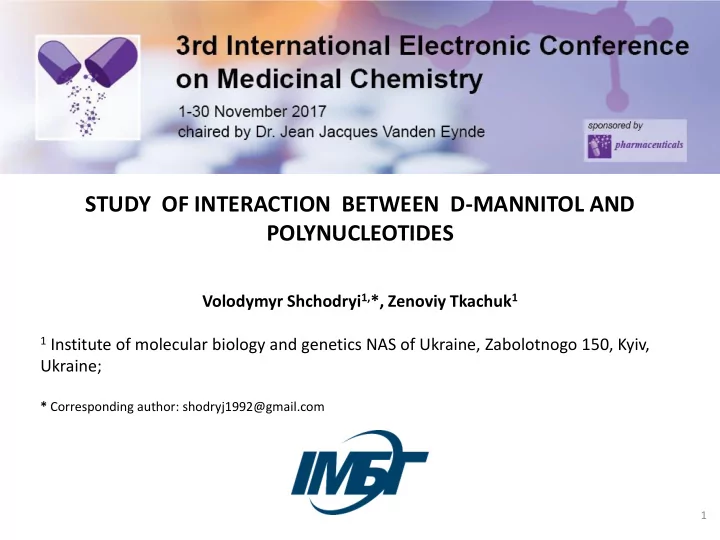

STUDY OF INTERACTION BETWEEN D-MANNITOL AND POLYNUCLEOTIDES Volodymyr Shchodryi 1, *, Zenoviy Tkachuk 1 1 Institute of molecular biology and genetics NAS of Ukraine, Zabolotnogo 150, Kyiv, Ukraine; * Corresponding author: shodryj1992@gmail.com 1
Abstract: The complexes of oligoribonucleotides with D-mannitol are highly effective, non- toxic and with a wide range of biological effects. Oligonucleotides without D-mannitol does not have such biological effect. During the research, we have observed the decrease of fluorescence intensity of the dye water solution with polyribonucleosides. An additional decrease of intensity was observed in complexes with D – mannitol. The maximum effect was obtained for fluorescent sensor solution with polyadenylate and polycytosine. In case of polyguanilate and polyuridine were observed minimum changes. The spectral effect may indicate a stronger interaction between polyadenylate and polycytosine with D-mannitol. Linear absorption was carried out in the temperature range from 25°C to 60°C. It was recorded the increase of intensity of absorption of the polynucleotides when increasing the temperature in cases of polyadenylate and polycytosine. The value of the hyperchromic effect was 10% for polyadenylate, and 5% for polycytosine. Additional increase of the amount of hyperchromic effect was recorded in complexes with D¬- mannitol. Using circular dichroism spectroscopy, different spectra were recorded for polyadenylate and polycytosine when compared with their complexes with D-mannitol. In case of polyguanilate and polyuridine and their complexes with D-mannitol similar spectra were recorded . Keywords: D-mannitol, polynucleotides, spectroscopy 2
Introduction The complexes of oligoribonucleotides with D- mannitol are highly effective, non-toxic and with a wide range of biological effects. In particular, such complexes can increase immune reactivity and have antiviral and anti-inflammatory activity. Oligonucleotides without D-mannitol does not have such biological effect. So, the study of such interactions is a very important task. Based on the experimental fact that the D – mannitol effects RNA, we can suppose that this effect is connected with an interaction of D – mannitol with nitrogen bases by hydrogen bonds between two parallel O H groups in the D – mannitol and one-coordinated oxygen atom and/or two-coordinated nitrogen atoms. 3
Results and discussion Possible formation of hydrogen bonds between the nitrogen bases and the D- mannitol molecule Cytidine + D-mannitol Uracil + D-mannitol Guanine + D-mannitol Adenine + D-mannitol 4
Results and discussion Titration results of dye with polynucleotides and their complexes with D-mannitol Dye + poly G Dye + polyA Dye + poly G + M Dye + polyA+M 1,00 1,00 0,95 0,95 0,90 0,90 Intensity a. u. Intensity a.u. 0,85 0,85 0,80 0,80 0,75 0,75 0,70 0,70 0,00000 0,00005 0,00010 0,00015 0,00020 0,00025 0,00030 0,00000 0,00005 0,00010 0,00015 0,00020 0,00025 0,00030 C, M C, M Dye + poly C Dye + poly U Dye + poly C + M 1,00 Dye + poly U + M 1,00 0,95 0,95 0,90 0,90 Intensity a. u. Intensity a.u. 0,85 0,85 0,80 0,80 0,75 0,75 0,70 0,70 0,00000 0,00005 0,00010 0,00015 0,00020 0,00025 0,00030 0,00000 0,00005 0,00010 0,00015 0,00020 0,00025 0,00030 C, M C,M We can observe quenching of the fluorescence intensity of the dye under the influence of polynucleotides and their complexes with D-mannitol. The most significant difference in changes of fluorescence intensity was observed in the case of polyadenylate and polycytosine and their complexes with D-mannitol In case of polyguanilate and polyuracile, changes of fluorescence intensity was not observed. 5
Results and discussion Absorbance melting spectra of polynucleotides We can observed changes in absorption spectra, which confirmed interactions of polyadenylate and polycytosine with D-mannitol and the appearance of an hyperchromic effect , values of the hyperchromic effect are given in brackets. Temperature ranged from 25°C to 60°C 6
Results and discussion Absorbance melting spectra of complexes of polynucleotides with D-mannitol The difference in the values of the hyperchromic effect in the presence and absence of D- mannitol for polyadenylate and polycytosine was 4% and 5% respectively. This indicates the formation of a new structure of polynucleotides, namely the possibility of forming a spiral with the participation of D-mannitol (the values of the hyperchromic effect are given in brackets). 7
Results and discussion Spectra of circular dichroism (CD) of polynucleotides with D-mannitol There are changes in the spectra of CD in the case of the interaction of polyadenylate and polycytosine with D-mannitol, indicating a change in the spatial structure of polynucleotides. In the case of the polyuracile and polyguanilate changes in the structure were not observed 8
Results and discussion Structure modeling of the binding of oligoadenylate to D- mannitol molecules The binding of three D-mannitol molecules with four oligoadenylate molecules occurs to nitrogen bases due to the formation hydrogen bonds. In the same time, molecules of D-mannitol can interact with each other. 9
Conclusions The obtained data allow us to assume the presence of an additional D-mannitol helix in the complex of polynucleotides with D-mannitol. This assumption is also confirmed by the simulation of this complex with the help of the program package Gaussian 09. Thus, a wide spectrum of antiviral action of the complex of polynucleotides and D-mannitol can be explained both against single stranded RNA viruses and double stranded DNA viruses . D – mannitol will bind with nitrogen bases by hydrogen bonds between two parallel O H groups in the D – mannitol and one-coordinated oxygen atom and/or two- coordinated nitrogen atom. D-mannitol is more effective in binding with polyadenylate and polycytosine. 10
Recommend
More recommend